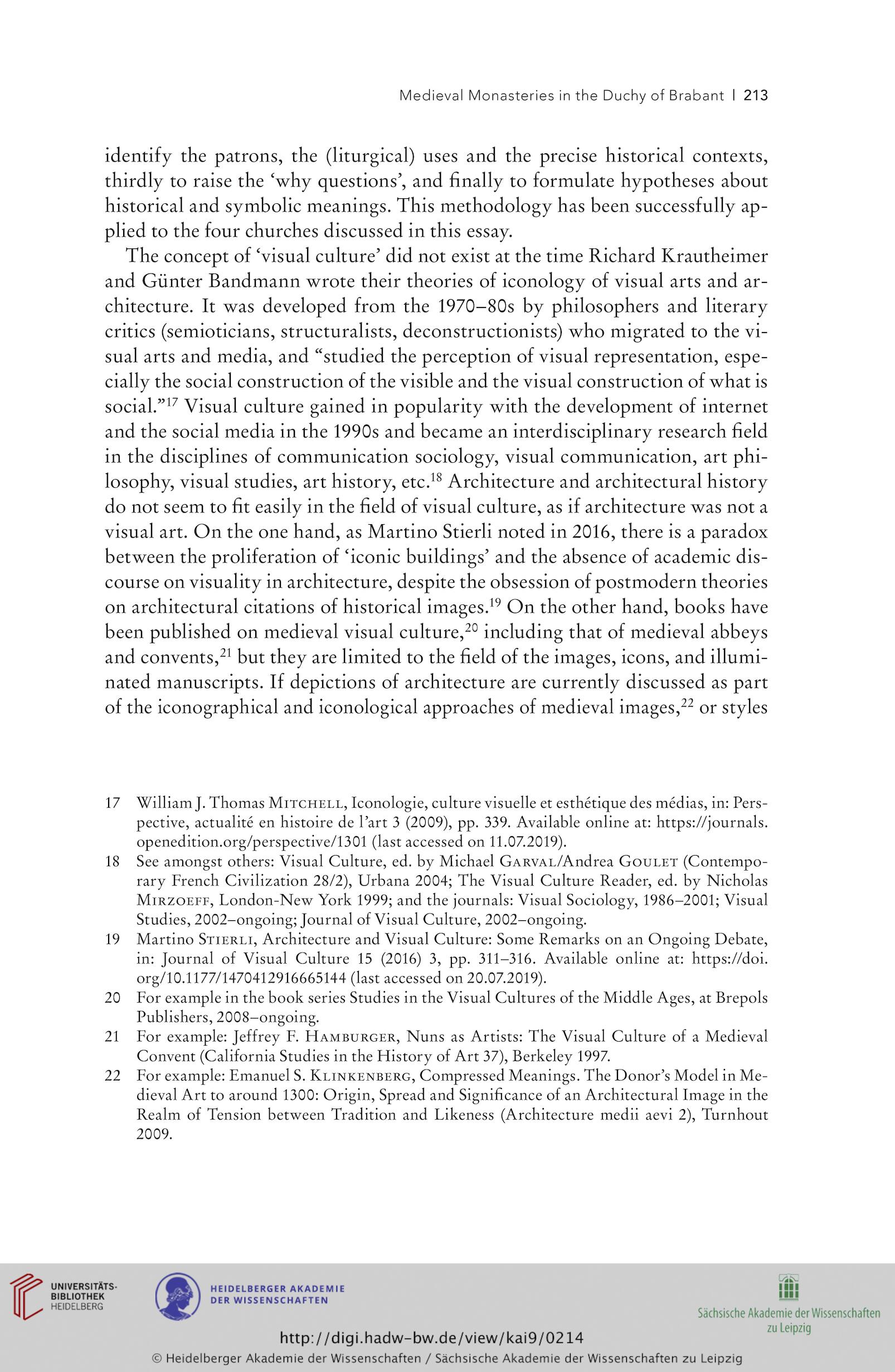Medieval Monasteries in the Duchy of Brabant I 213
identify the patrons, the (liturgical) uses and the precise historical contexts,
thirdly to raise the 'why questions', and finally to formulate hypotheses about
historical and symbolic meanings. This methodology has been successfully ap-
plied to the four churches discussed in this essay.
The concept of 'visual culture' did not exist at the time Richard Krautheimer
and Günter Bandmann wrote their theories of iconology of visual arts and ar-
chitecture. It was developed from the 1970—80s by philosophers and literary
critics (semioticians, structuralists, deconstructionists) who migrated to the vi-
sual arts and media, and "studied the perception of visual representation, espe-
cially the social construction of the visible and the visual construction of what is
social."17 Visual culture gained in popularity with the development of internet
and the social media in the 1990s and became an interdisciplinary research field
in the disciplines of communication sociology, visual communication, art phi-
losophy, visual studies, art history, etc.18 Architecture and architectural history
do not seem to fit easily in the field of visual culture, as if architecture was not a
visual art. On the one hand, as Martino Stierli noted in 2016, there is a paradox
between the proliferation of 'iconic buildings' and the absence of academic dis-
course on visuality in architecture, despite the obsession of postmodern theories
on architectural citations of historical images.19 On the other hand, books have
been published on medieval visual culture,20 including that of medieval abbeys
and convents,21 but they are limited to the field of the images, icons, and illumi-
nated manuscripts. If depictions of architecture are currently discussed as part
of the iconographical and iconological approaches of medieval images,22 or styles
17 William J. Thomas Mitchell, Iconologie, culture visuelle et esthetique des medias, in: Pers-
pective, actualite en histoire de Tart 3 (2009), pp. 339. Available online at: https://journals.
openedition.org/perspective/1301 (last accessed on 11.07.2019).
18 See amongst others: Visual Culture, ed. by Michael GARVAL/Andrea Goulet (Contempo-
rary French Civilization 28/2), Urbana 2004; The Visual Culture Reader, ed. by Nicholas
Mirzoeff, London-New York 1999; and the journals: Visual Sociology, 1986-2001; Visual
Studies, 2002—ongoing; Journal of Visual Culture, 2002—ongoing.
19 Martino Stierli, Architecture and Visual Culture: Some Remarks on an Ongoing Debate,
in: Journal of Visual Culture 15 (2016) 3, pp. 311-316. Available online at: https://doi.
org/10.1177/1470412916665144 (last accessed on 20.07.2019).
20 For example in the book series Studies in the Visual Cultures of the Middle Ages, at Brepols
Publishers, 2008-ongoing.
21 For example: Jeffrey F. Hamburger, Nuns as Artists: The Visual Culture of a Medieval
Convent (California Studies in the History of Art 37), Berkeley 1997.
22 For example: Emanuel S. Klinkenberg, Compressed Meanings. The Donor's Model in Me-
dieval Art to around 1300: Origin, Spread and Significance of an Architectural Image in the
Realm of Tension between Tradition and Likeness (Architecture medii aevi 2), Turnhout
2009.
identify the patrons, the (liturgical) uses and the precise historical contexts,
thirdly to raise the 'why questions', and finally to formulate hypotheses about
historical and symbolic meanings. This methodology has been successfully ap-
plied to the four churches discussed in this essay.
The concept of 'visual culture' did not exist at the time Richard Krautheimer
and Günter Bandmann wrote their theories of iconology of visual arts and ar-
chitecture. It was developed from the 1970—80s by philosophers and literary
critics (semioticians, structuralists, deconstructionists) who migrated to the vi-
sual arts and media, and "studied the perception of visual representation, espe-
cially the social construction of the visible and the visual construction of what is
social."17 Visual culture gained in popularity with the development of internet
and the social media in the 1990s and became an interdisciplinary research field
in the disciplines of communication sociology, visual communication, art phi-
losophy, visual studies, art history, etc.18 Architecture and architectural history
do not seem to fit easily in the field of visual culture, as if architecture was not a
visual art. On the one hand, as Martino Stierli noted in 2016, there is a paradox
between the proliferation of 'iconic buildings' and the absence of academic dis-
course on visuality in architecture, despite the obsession of postmodern theories
on architectural citations of historical images.19 On the other hand, books have
been published on medieval visual culture,20 including that of medieval abbeys
and convents,21 but they are limited to the field of the images, icons, and illumi-
nated manuscripts. If depictions of architecture are currently discussed as part
of the iconographical and iconological approaches of medieval images,22 or styles
17 William J. Thomas Mitchell, Iconologie, culture visuelle et esthetique des medias, in: Pers-
pective, actualite en histoire de Tart 3 (2009), pp. 339. Available online at: https://journals.
openedition.org/perspective/1301 (last accessed on 11.07.2019).
18 See amongst others: Visual Culture, ed. by Michael GARVAL/Andrea Goulet (Contempo-
rary French Civilization 28/2), Urbana 2004; The Visual Culture Reader, ed. by Nicholas
Mirzoeff, London-New York 1999; and the journals: Visual Sociology, 1986-2001; Visual
Studies, 2002—ongoing; Journal of Visual Culture, 2002—ongoing.
19 Martino Stierli, Architecture and Visual Culture: Some Remarks on an Ongoing Debate,
in: Journal of Visual Culture 15 (2016) 3, pp. 311-316. Available online at: https://doi.
org/10.1177/1470412916665144 (last accessed on 20.07.2019).
20 For example in the book series Studies in the Visual Cultures of the Middle Ages, at Brepols
Publishers, 2008-ongoing.
21 For example: Jeffrey F. Hamburger, Nuns as Artists: The Visual Culture of a Medieval
Convent (California Studies in the History of Art 37), Berkeley 1997.
22 For example: Emanuel S. Klinkenberg, Compressed Meanings. The Donor's Model in Me-
dieval Art to around 1300: Origin, Spread and Significance of an Architectural Image in the
Realm of Tension between Tradition and Likeness (Architecture medii aevi 2), Turnhout
2009.






